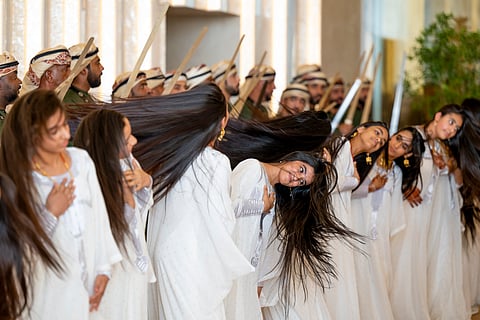What the Al Ayyala dance means and why it was performed during Donald Trump’s visit to the UAE
Cultural expert explains the role of Ayyala performace in Emirati heritage and hospitality

Dubai: When US President Donald Trump arrived in the UAE, marking the first visit by a sitting US president in 17 years, he was received by President His Highness Sheikh Mohamed bin Zayed Al Nahyan and welcomed with a traditional Emirati cultural performance.
One of the most striking moments of the ceremony was the traditional dance performed by young Emirati girls, during which they rhythmically tossed their hair back and forth.
This cultural display sparked curiosity online, with many people around the world keen to understand the nature and significance of the tradition.
Ahmed Bel Jafflah, senior presenter and protocol manager at the Sheikh Mohammed Bin Rashid Al Maktoum Centre for Cultural Understanding (SMCCU), explained to Gulf News the symbolism and importance of the dances performed.
“The traditional performances of the UAE, such as the Ayyala dance and the local hair dance by girls referred to as Naa’shaat, are powerful expressions of the country’s cultural identity and values. The Ayyala, performed by men in two rows, is a symbol of unity, pride, and heritage – recognised by UNESCO as an Intangible Cultural Heritage of Humanity. It is more than just a performance, it is woven into the social fabric of Emirati life,” Jafflah said.
Why was the Al Ayyala performed during Trump’s visit?
Jafflah noted that the Ayyala is traditionally performed at weddings, often continuing over several days to express joy and togetherness. “It is also used to welcome visitors, during Eid celebrations, on National Day, and at official state events. These moments reflect the Emirati spirit of hospitality, happiness, and inclusion,” he said.
The performance by young Emirati girls, featuring flowing hair movements, carries equal cultural significance.
“The graceful movement of their hair reflects modesty, elegance, and a unique form of expression that honours their role in welcoming and celebrating guests,” he added.
Ayyala is performed at weddings, often over three days to celebrate joy and togetherness. It is also used to welcome visitors after, during Eid celebrations, on National Day, and at official state events. These moments reflect the Emirati spirit of hospitality, happiness, and inclusion.

About the Al Ayyala – a cultural performance practised in north-western Oman and the UAE
According to UNESCO, the Ayyala is a popular and expressive cultural tradition also practised in Oman. It typically features two rows of around twenty men facing each other, carrying thin bamboo sticks that represent spears or swords. Musicians perform between the rows, playing large and small drums, tambourines, and brass cymbals.
The men move their heads and sticks in synchrony with the rhythm while chanting poetic verses. Additional performers may move between the rows holding swords or rifles, which are sometimes thrown into the air and caught as part of the performance.
In the UAE, girls dressed in traditional attire stand at the front, rhythmically tossing their long hair from side to side.
“Together, these traditions demonstrate how the UAE continues to celebrate its heritage with pride, sharing it with the world in a way that is inclusive, joyful, and deeply respectful,” Jafflah emphasised.
Sign up for the Daily Briefing
Get the latest news and updates straight to your inbox






